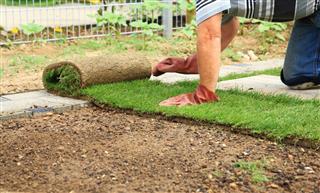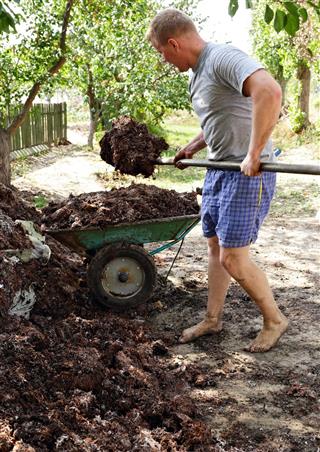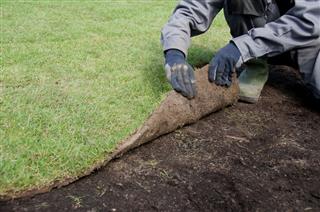
Many people believe that leveling a yard is a very difficult task, and often end up procrastinating on the task or calling experts and wasting a substantial amount of money. In reality, leveling an existing yard is not that difficult a job.
A yard is usually a piece of land that is attached to a house or a building. A yard has variable uses, like at times, it is used as a front porch or sometimes, animals like horses are let loose into the yard. Most of the yards are grass yards and are located outside that building. However, some like the courtyards, are located within the house. The courtyard is usually located at the midpoint of the house and is surrounded from all sides by the different wings of the house. The courtyard of almost all the houses will have a solid flooring and is rarely made up of grass or soil. The yards that are made up of soil are rarely seen, except in tropical and sub tropical regions, where they usually adjoin the houses.
How to Level a Yard
Turf Removal
The first step that is to be implemented in the process of leveling the yard is to remove the turf that already exists. The old turf is bound to be full of weeds and unwanted plants, if your yard has been kept untended for a long time. The best way to get rid of such plants, is to uproot unwanted growth one by one. This process may take a while and requires a lot of patience.
However, unwanted and new, alien plants will not grow in the yard, once the new grass is planted. You can also resort to some other techniques like soil solarization or use of herbicides. However, these methods, though convenient, are not very advisable. After you are done with the process of pulling out the weeds, pile them in one corner of the yard.
Downward Slope
While leveling an existing yard, one has to bear in mind that the yard should slope away from the house. Hence it is recommended that the yard should have a 3 to 2 inches downward slope every 10 feet or so. Thus, the yard will not have any problems, such as water accumulation or unevenness, during the rainy season. The gradual slope of the water facilitates a decent outflow of water from the yard and thus, does not disturb any soil on top.
While leveling your yard, avoid using any new soil as it results into an nonuniform growth of grass. The best way is to use simple tools and scrape and shift the soil on higher areas and bring it down to the lower areas. A large shovel or a broad snow or gardening spade also works wonders. After you are done with filling up the soil using a simple shovel and a simple Inclinometer (you may also use a Clinometer or Tiltmeter having simple mechanism), you can slowly give the ground the desired slope. Instead of the shovel, one can also use a plank of wood. This process may require more than one day, so do not level your yard in the rainy season, as the condition of the yard may worsen.
Filling up Gaps and Depressions
It is also possible that one may encounter sudden gaps and depressions along the yard. In order to fill them up, dig the gap or depression area into one single ditch and then fill it up with coarse rocks, gravel and then finer soil. Next level up the filled up area so that its upper surface merges properly with the remaining area.
You will have to use an Inclinometer, then re-level the entire area, plenty of times so that it becomes uniform and integrated with the remaining yard.
Final Finish to the Leveling
In the final process of leveling the yard, you will need to add the finishing touches to the final surface of the yard. In this case, you can use, spades, snow shovels and rakes. Though using a rake is patience-testing, it makes the slope as even as possible and the leveling itself becomes very even. You may also add thin layer of organically rich soil while doing the final leveling.
You will need to use the Inclinometer constantly for conforming the elevation. Also, make sure that the leveling is foolproof as once you plant and set the turf, you cannot re-do the surface, you will need to uproot the entire turf again. Hence, make it a point to take your time and keep on adding the finishing touches till you are satisfied and then proceed to plant the turf. Some people also bring in a road-roller for a couple of days to make sure that the yard is finished properly.
Planting the Turf
There are three ways of planting the turf. Firstly, you can manually plan small turf saplings of the grass or reseed the lawn. This process is quite long and requires an expert’s hand. Secondly, you can use your older removed turf if it is in good shape.The third way is that you can plant the lawn by using ‘lawn carpet’. Now, what is a lawn carpet? A lawn carpet is a simple patch of rectangular grass that can be laid down like a carpet in your yard.
The lawn carpet is pretty inexpensive and can be laid down to cover a whole yard. It is, however, important to lay down the carpet properly and evenly, so that you do not have a problem of uneven ground later on. Also when you visit the nursery, make sure that you purchase all the pieces of carpet from the same batch and which have the same age. A difference in the batch will give you different lawn patterns in your yard. Once planted the lawn carpet pieces grow evenly and uniformly on their own. A lawn carpet is sometimes also referred to as a sod carpet. The next step, which is the final step, is to lay down some good, natural and organic lawn fertilizer. For this propose, spread the fertilizer in the thinnest possible layer. Avoid concentration of the fertilizer in one single place, as it disturbs the gradual slope of land.
It is also necessary to use the lawn mower on the lawn periodically and in a consistent manner. Finally, the best way to level a yard is to give it time to grow and use proper lawn care measures.









